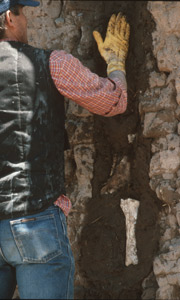Dust to Dust: The Utilization of Bones in Adobe Repair
Ed Crocker
Walls that have been severely eroded by channeling water are one of the most frequently encountered problems in earthen architecture. Interior or exterior damage is typically caused by runoff from flat or pitched roofs that do not extend adequately at the eave, or are themselves damaged thus allowing water to enter the walls at separations or joints. Channeling can result in damage that ranges from superficial erosion of the plaster to complete failure of the wall. The church at Pajarito, near San Ildefonso Pueblo, had been abandoned for nearly fifty years prior to restoration and provided examples of every level of damage to both roof and walls.
Wind had separated many of the metal roof panels and the walls of the church were, as a result, in state of terrible disrepair. Where erosion had penetrated the full width of the wall, the old adobes were selectively removed in a "toothed" pattern, and replaced with new bricks interlocking with the old. Where the walls had become free standing, adobes were removed in a "stepped" configuration on both sides of the damaged area and rebuilt from the footing up. In instances where erosion had removed one-half to two-thirds of the fabric in cross section, an unlikely but perfectly logical traditional technology emerged from the community that was engaged in the repairs. Instead of cleaning and sculpting the damaged area to receive adobes, and rather than applying thin layers of mud repeatedly to fill the voids, the community called upon its memories of similar repairs made many years earlier.
 First, several of the women were dispatched to recover dried animal bones from the surrounding pasture. The bones were then sorted roughly by size and shape. As repairs began, the damaged wall was saturated with water containing a small amount of lime. The mud, also containing lime water, was mixed to a barely workable consistency and thrown forcefully into the channel where it adhered to the dampened adobes. When several inches of mud was in place, the bones, after they had been dipped in the lime water, were embedded. In some spots they were placed so as to form a "bridge" between protrusions of old adobe. This usually involved the longer, straighter bones. Where the mud was applied so thickly that it began to sag and pull away from the wall, the wider, flatter bones were embedded. As I watched the process, I commented that such a hasty, one-step method of infilling was likely to crack and fall out as it dried. I was admonished that not a crack would appear and that adhesion and strength were not being compromised. No cracks appeared and when I expressed amazement I was subjected to a good natured lecture that began, "You know, it was good enough for grandpa . . ."
First, several of the women were dispatched to recover dried animal bones from the surrounding pasture. The bones were then sorted roughly by size and shape. As repairs began, the damaged wall was saturated with water containing a small amount of lime. The mud, also containing lime water, was mixed to a barely workable consistency and thrown forcefully into the channel where it adhered to the dampened adobes. When several inches of mud was in place, the bones, after they had been dipped in the lime water, were embedded. In some spots they were placed so as to form a "bridge" between protrusions of old adobe. This usually involved the longer, straighter bones. Where the mud was applied so thickly that it began to sag and pull away from the wall, the wider, flatter bones were embedded. As I watched the process, I commented that such a hasty, one-step method of infilling was likely to crack and fall out as it dried. I was admonished that not a crack would appear and that adhesion and strength were not being compromised. No cracks appeared and when I expressed amazement I was subjected to a good natured lecture that began, "You know, it was good enough for grandpa . . ."
I speculate that the technical reasons for the success of this method of infill have both mechanical and chemical components. The irregularly shaped bones embedded in mud act much as re-bar does when embedded in cement. The key to strength in both cases is in the quality of the material surrounding the reinforcing element. The addition of lime to the water which was used to saturate everything pertaining to the repair provided a unifying binder: Where the saturated wall came in contact with infill, the calcium hydroxide in both re-carbonated simultaneously, eliminating to some significant degree an interface between the new and the old materials; calcium carbonate in the mud acted as a soil stabilizer, and the high level of calcium phosphate in the bones provided another compatible medium for the penetration and bonding of calcium hydroxide. The whole repair contained a thorough calcium carbonate matrix when dry.
It is not uncommon to see bones protruding from earthen walls in prehistoric as well as historic settings. The experience at Pajarito may prove enlightening as to their presence, which it would seem is not accidental.

